Tx Tees for Dummies
Wiki Article
An Unbiased View of Tx Tees
Table of ContentsRumored Buzz on Tx TeesThe Definitive Guide for Tx TeesNot known Details About Tx Tees The Buzz on Tx TeesThe Best Strategy To Use For Tx TeesSee This Report about Tx TeesMore About Tx Tees
Add up various other prices, like the number of utilities it takes to run the shop and the price of ink and solution per design. Take the print below.The solution should only be a couple of cents since you 'd just need to layer one display for this work. Generally, printers try to make up to 45% earnings on a print task.

With DTF, you can print a handful of shirts, or simply one. Use the same calculator as the area over to calculate just how much revenue you 'd use DTF transfers. Contrast the expenses and earnings to whichever technique talks ideal to your setup and procedure. Both display printing and DTF have their niches worldwide.
The Facts About Tx Tees Uncovered
The very best way to know? Ask about and see what printing shop like yours are doing. custom screen printing. Try both out and see which you like far better
When you're choosing what sort of printing technique to utilize for printing your artwork layouts on your garments, it is very important that you understand the distinctions in between these two techniques so you can make the most of outcomes while decreasing prices. Screen printing is one of the most frequently used strategy for printing layouts on textiles.
DTG printing is also called place or straight to garment printing since it prints only what is required rather than making a screen as display printers do. https://txtees02.edublogs.org/2024/03/28/revolutionize-your-style-with-custom-t-shirt-design/. Screen printing functions by screen filler squeegee display printing ink screen mesh display, after that moving the picture to garment using warmth and/or pressure
The DTG printer uses special dye-sublimation inks that are applied right into a pre-designed picture by a digital printing system. The inks enter into the fabric, permitting for vibrant shades and extraordinary detail. It's likewise called spot or straight to garment printing since it publishes just what is needed rather of making a display as screen printers do.
A Biased View of Tx Tees
It's much quicker - you can publish a fullcolor image in minutes, as opposed to hours for display printing. Second, there's no established up time or prices involved - you can publish any layout you such as, without having to develop a display. Third, there's no waste - because screen printers display print one design at a time, they need to screen each color individually.
The paper is very costly and can only be used when. Once it's printed on, it needs to be disposed of. - The initial acquisition rate is less than the upfront investment of DTG printers- You can publish multi-color designs one screen at once instead of needing to publish each shade individually like DTG printing.

Getting The Tx Tees To Work
However, rather than making use of display mesh as screen printers do, dye sublimation printers use laser modern technology to transfer your pictures onto garments or paper. A heat process moves the dye from its solid-state straight right into the gas phase which in turn merges it onto fabric substratums when they are swiftly heated up to high temperatures under high stress.Sublimation printing is environment-friendly. It uses less water than screenprinting, and since it does not entail making use of unsafe solvents, it's risk-free for all types of garments. The dye sublimation inks are also odor free when healed, unlike display printers that use hazardous chemicals during the display printing process that leave behind an unpleasant odor.
They likewise save cash on pricey tools like direct exposure devices considering that color sublimation printers don't need a UV direct exposure unit or a flash treatment stove that is generally used in screen printing (custom cap printing). What is direct to garment printing (DTG Printing)? DTG printing is a digital screenprinting process that publishes straight onto fabric utilizing specialized inkjet printers
Tx Tees - Questions
DTG printing provides many advantages over conventional screenprinting, consisting of the ability to publish photo top quality images, better color vibrancy, and the capability to print styles on darker materials. DTG printers work by warming the fabric ink up until it turns right into a gas. The gas then penetrates the material, bonding with the fibers to develop an irreversible print.
Screen printers merely prepare their screen then start publishing up until they run out of item or ink.- There is a vast array of knowledgeable display printers all over the world, which can be valuable for newbies. - It's a slower procedure - display printers frequently need to await the ink to dry before they can print the following shade- Screen printers need manual labor, so there's a higher knowing curve and it takes longer to produce a top quality style- Screen printing isn't as exact as DTG printing, so you might obtain some "blood loss" of colors from one component of the image onto one more otherwise done effectively.
Tx Tees Can Be Fun For Anyone
Nonetheless, rather than utilizing display mesh as screen printers do, color sublimation printers use laser modern technology to transfer your images onto garments or paper. A heat process moves the dye from its solid-state straight into the gas phase which subsequently merges it onto fabric substrates when they are swiftly heated to heats under high stress.Sublimation printing is environmentally friendly. It makes use of less water than screenprinting, and since it does not involve using damaging solvents, it's secure for all sorts of clothing. The color sublimation inks are likewise unsmelling when cured, unlike display printers that make use of damaging chemicals throughout the screen printing process that leave an undesirable odor.
They also save cash on costly devices like direct exposure units given that dye sublimation printers don't need a UV direct exposure system or a flash cure oven that is normally used in screen printing. What is direct to garment printing (DTG Printing)? DTG printing is an electronic screenprinting process that prints straight onto textile making use of specialized inkjet printers.
The 5-Second Trick For Tx Tees
DTG printing uses many benefits over traditional screenprinting, consisting of the capacity to publish photographic quality images, higher color vibrancy, and the ability to publish styles on darker textiles. DTG printers function by warming the textile ink up until it becomes a gas. The gas then penetrates the material, bonding with the fibers to produce a permanent print.Report this wiki page